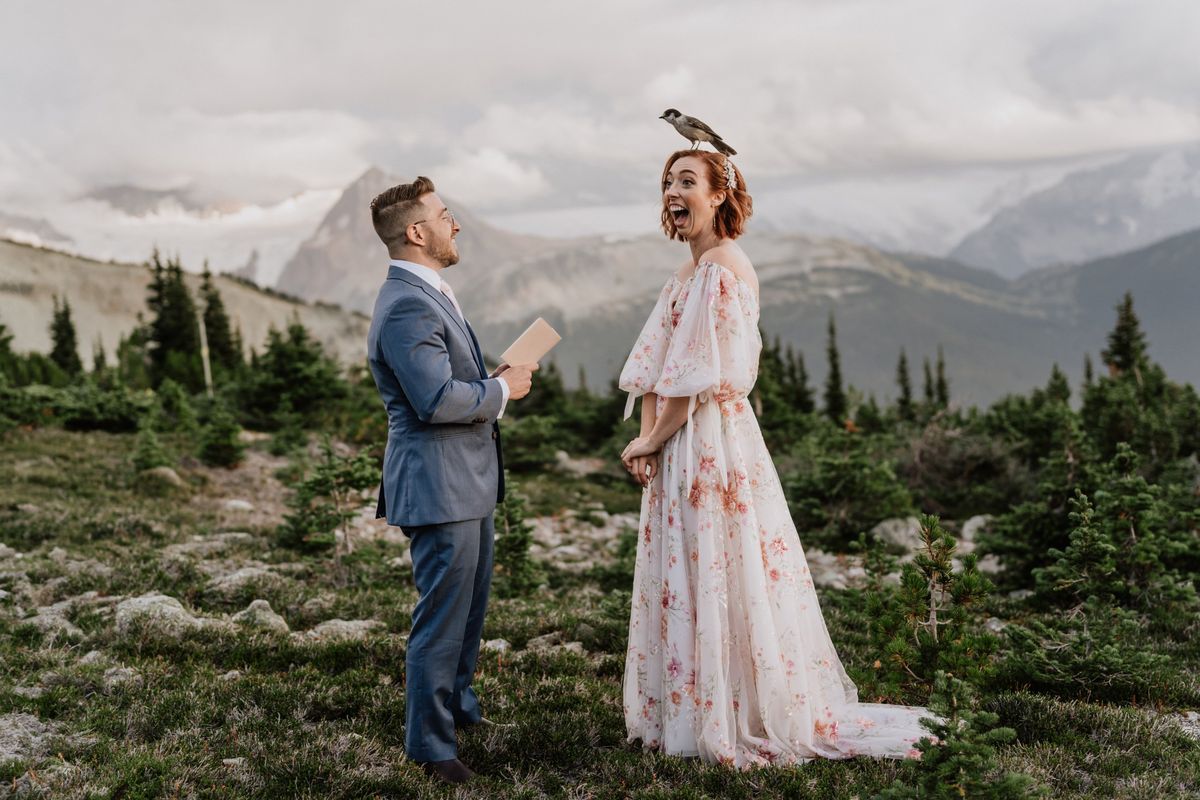11 award-winning photos that captured lovely and laughable wedding moments from 2023
Weddings bring up all kinds of emotions. These photographers knew exactly how to celebrate that.

this year's IWPOTY gave us a Disney princess
Just like the love bonds they celebrate, weddings contain a multitude of feelings—romance, commitment, joy, silliness, both reverence and irreverence all at the same time.
And wedding photographers are given the challenging task of capturing each of those emotions stirred throughout the event. Somehow, through their handful of images, we are supposed to get a glimpse into the unique lives parents are creating together. It’s obviously not easy, but the great photographers make it look effortless.
Every year, the International Wedding Photographer of the Year (IWPOTY) Awards takes entries of outstanding wedding photography from around the globe in various categories like Epic Location, Solo Portrait, and Break the Rules.
Judges selected the most memorable images from 1,700 submissions, and 2023’s winners include a rock-climbing bride and groom, a breathtaking aerial photo, and a moonlit kiss that belongs in a fairytale.
But the grand prize went to something much sillier. Canadian photographer Tara Lilly won the title for capturing the exact moment a bird landed right atop a bride’s head, sending her into a giggle fit and instantly turning her into a whimsical Disney princess.

The IWPOTY grand prize winner.
Tara Lilly Photography/International Wedding Photographer of the Year 2023
"Just as Mitch began his vows, a curious whiskey jack swooped in and landed directly on top of Mikaela's head," Lilly wrote on the contest website. "Mikaela's shock, surprise and laughter were not enough to dissuade this bird from his perch. 'I'm Snow White!' Mikaela laughed."
Judge and photographer Dee Kampe, who won last year's contest, said Lilly’s lighthearted image was picked the winner because “it encapsulates the emotions and narrative that runs through an entire wedding day in a single frame.”
Meanwhile, a heavy dose of dramatic lighting earned Carmelo Ucchino a Runner-Up title, as well as winning the Dance Floor category.

The IWPOTY The Dance Floor winner.
Carmelo Ucchino/International Wedding Photographer of the Year 2023
In her submission Ucchino noted that the surreal ring of light dancing around the couple is water, meant to add a surreal element to the moment and symbolize how the deep emotion of a wedding “comes to life through the bride and groom.”
Aimée Flynn won the Couple Portrait category, thanks to an incoming desert storm.

The IWPOTY Couple Portrait winner.
Aimée Flynn/International Wedding Photographer of the Year 2023
"The nice thing is that in places as wide open as the desert, you can […] often see weather approaching… and you can see when that weather will clear, making for the prettiest and moodiest sunset ever," Flynn explained.
"There was so much joyful shrieking as this couple scrambled over the rocks, wind whipping their hair and clothes," she added. "It was chilly and windy, but these two had the time of their lives embracing their (very epic) wedding day."
Flynn also won the Epic Location category for her shot of a couple stealing a sky high kiss.

The IWPOTY Epic Location winner.
Aimée Flynn/International Wedding Photographer of the Year 2023
Flynn knew that since the soon-to-be husband and wife were avid climbers, that their shared passion would be the foundation of their engagement photo. But the rest was purely incidental.
I was turning around to find a new vantage point for photos when I heard, 'Oh, Spiderman style!' from behind me…I looked over my shoulder and saw, well, this, and then frantically started taking photos,” she said, adding, "it's wild to think I had very little to do with the set up of this photo and that this was genuinely just the two of them having fun.”
Winning the top prize for the From Above category, Ben Lane of Tinted Photography's vivid photo shows a couple lying on a dock.

The IWPOTY From Above winner
Tinted Photography/International Wedding Photographer of the Year 2023
“We started our day super early with Marianne and Jeremy to catch the sun rising across Lago Di Braies,” Lane wrote. “Later, they would say their vows to each other, surrounded by the indescribable peaks of the Italian Dolomites. But in between was this moment. We had the jetty to ourselves; the lake was dead calm, the row boats still in their moorings. It was a perfect time for these two to take a moment and just relax with each other.
And then this gorgeous image of bride and groom walking in front of a cathedral, taken by Fabio Mirulla, won the Black and White category.

The IWOPTY Black and White winner.
Fabio Mirulla/International Wedding Photographer of the Year 2023
“I always try to put order to the ‘chaos’ of the world through the lenses of my camera, sometimes through geometries,” Mirulla shared.
And that sentiment is certainly felt in his image. As Mirulla explained, everything came together as the couple was walking down a picturesque street in Italy.
"I turned around and saw that there was a cone of light projecting this very strong shadow against Palazzo del Rettorato," he said. "I immediately took the chance to play with frames to create something different, a strong geometry totally in contrast and discontinuous with the usual aspect of the city which is a purely medieval town with its typical bricks."
"The success of a photo sometimes is being in the right place at the right time and this was definitely the case," he added.
This lively and fun picture of a bridal party won Jeff Tisman the top prize in the "I-Do" Crew category.

The IWPOTY "I-Do" Crew winner.
Jeff Tisman Photography/International Wedding Photographer of the Year 2023
As Tisman explained in his submission, his goal is to not only offer clients photos, but to give them “an experience.”
For this experience, Tisman had previously taken a bridal party photo of only eight people. When the couple asked him if he could fit all 16 in, to which Tisman replied,” only one way to find out.” And the rest is history.
Another black-and-white photo won the Engagement/Non-Wedding category—this one of a couple diving in the Cook Islands, taken by Julian Zeman.

The IWPOTY Engagement/Non-Wedding winner.
Julian Zeman/International Wedding Photographer of the Year 2023
Zeman wrote that the couple pictured, Steph and Matt, are both marine biologists, so “it was only fitting they merge their passion for the ocean and their love for each other with an underwater photoshoot.”
Though the waters were “choppy” that day, everyone navigated through them beautifully.
This incredible photo of a couple repelling under the stars was taken by Traci Edwards, giving her the winning image of IWPOTY’s Break the Rules category.

The IWPOTY Break the Rules winner.
Traci Edwards/International Wedding Photographer of the Year 2023
"When planning with Gillian and Josh, it was clear how much climbing was a part of their relationship," Edwards wrote in her submission. "Their first date was on a multi-pitch trad route and they got engaged on an epic sport route in Moab. The main things they wanted to be a part of their day: warmth, time to enjoy, climbing, beer and stargazing."
Edwards’ idea wouldn’t be easy to pull off, but “With practice, holding our breaths and some help from passing cars” they ended up with an image that the couple could look back on for years to come.
Shankhesh Jariwala became the Solo Portrait winner with an image that “instantly creates a story.”

The IWPOTY Solo Portrait winner.
Shankhesh Jariwala/International Wedding Photographer of the Year 2023
“While capturing [the] bride's solo portrait I saw this painting on the wall which was hanging a little higher [and] I instantly created the story in my mind about the painting. I asked [the] bride if she could stand on the little table with those high heels on and she trusted my vision and agreed to do for her perfect bridal portrait,” Jariwala shared in her submission.
Lastly, heaven and earth aligned for Van Middleton to take first place in the Lit category with her otherworldly moonlit photo.

The IWPOTY Lit winner.
Van Middleton Photography/International Wedding Photographer of the Year 2023
"There was a full moon that was tracing a line right between two beautiful big old trees near the wedding venue, and I had a couple that was super excited to be involved in a few outdoors nighttime creative photos (while their friends were partying hard inside!)," he wrote.
Luckily, Middleton had borrowed an LED light from a colleague, which really helped give the couple that standout silhouette.



 Tony Trapani received the most important letter of his life, but he didn't see it for 50 years Photo by
Tony Trapani received the most important letter of his life, but he didn't see it for 50 years Photo by  Tony and Samuel didn't waste time thinking about what might have been if he'd seen the letter earlier. Photo by
Tony and Samuel didn't waste time thinking about what might have been if he'd seen the letter earlier. Photo by 




 A woman running in the desert.via
A woman running in the desert.via  A group of friends hangining out in nature.via
A group of friends hangining out in nature.via